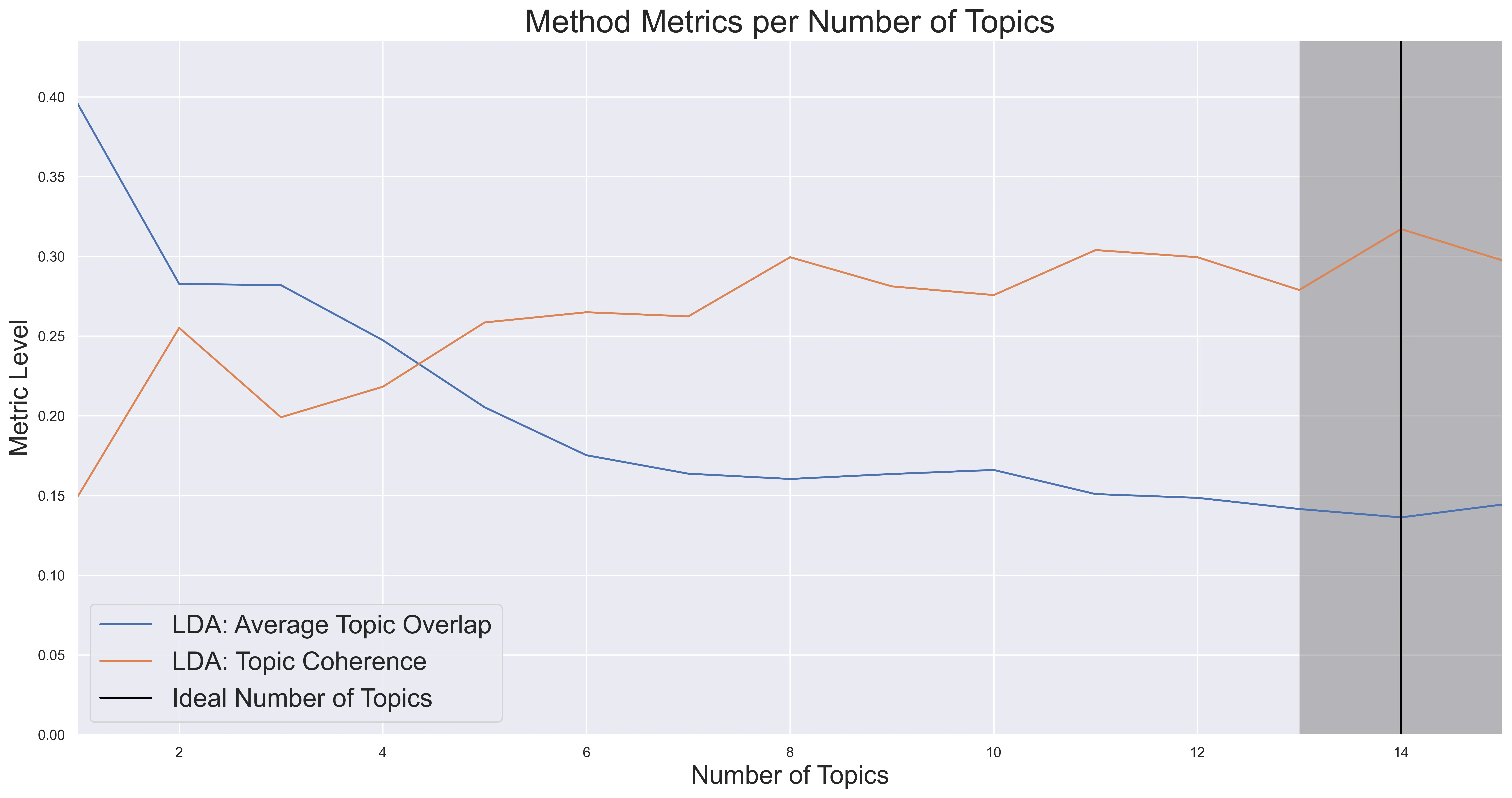一般的经验法则是创建不同主题数的LDA模型,然后检查每个模型的
Jaccard相似度和连贯性。在这种情况下,连贯性通过主题中得分高的词之间的语义相似度来衡量(这些词是否在文本语料库中同时出现)。以下内容将为最佳主题数提供强烈的直觉。在尝试使用分层狄利克雷过程之前,应该先建立一个基线,因为在实际应用中发现该技术存在问题。
首先,为你想要考虑的各种主题数量创建模型和主题单词的字典,其中在这种情况下,
corpus是清理后的标记,
num_topics是你想要考虑的主题列表,
num_words是你想要考虑的每个主题的前几个高频词的数量。
import seaborn as sns
import matplotlib.pyplot as plt
import numpy as np
from gensim.models import LdaModel, CoherenceModel
from gensim import corpora
dirichlet_dict = corpora.Dictionary(corpus)
bow_corpus = [dirichlet_dict.doc2bow(text) for text in corpus]
num_topics = list(range(16)[1:])
num_keywords = 15
LDA_models = {}
LDA_topics = {}
for i in num_topics:
LDA_models[i] = LdaModel(corpus=bow_corpus,
id2word=dirichlet_dict,
num_topics=i,
update_every=1,
chunksize=len(bow_corpus),
passes=20,
alpha='auto',
random_state=42)
shown_topics = LDA_models[i].show_topics(num_topics=i,
num_words=num_keywords,
formatted=False)
LDA_topics[i] = [[word[0] for word in topic[1]] for topic in shown_topics]
现在创建一个函数来计算两个主题的Jaccard相似度:
def jaccard_similarity(topic_1, topic_2):
"""
Derives the Jaccard similarity of two topics
Jaccard similarity:
- A statistic used for comparing the similarity and diversity of sample sets
- J(A,B) = (A ∩ B)/(A ∪ B)
- Goal is low Jaccard scores for coverage of the diverse elements
"""
intersection = set(topic_1).intersection(set(topic_2))
union = set(topic_1).union(set(topic_2))
return float(len(intersection))/float(len(union))
使用上述方法通过考虑下一个主题来推导跨主题的稳定性均值:
LDA_stability = {}
for i in range(0, len(num_topics)-1):
jaccard_sims = []
for t1, topic1 in enumerate(LDA_topics[num_topics[i]]):
sims = []
for t2, topic2 in enumerate(LDA_topics[num_topics[i+1]]):
sims.append(jaccard_similarity(topic1, topic2))
jaccard_sims.append(sims)
LDA_stability[num_topics[i]] = jaccard_sims
mean_stabilities = [np.array(LDA_stability[i]).mean() for i in num_topics[:-1]]
gensim内置了一个主题连贯性模型(使用'c_v'选项):
coherences = [CoherenceModel(model=LDA_models[i], texts=corpus, dictionary=dirichlet_dict, coherence='c_v').get_coherence()\
for i in num_topics[:-1]]
从这里可以通过每个主题的连贯性和稳定性之间的差异大致推导出理想的主题数量:
coh_sta_diffs = [coherences[i] - mean_stabilities[i] for i in range(num_keywords)[:-1]]
coh_sta_max = max(coh_sta_diffs)
coh_sta_max_idxs = [i for i, j in enumerate(coh_sta_diffs) if j == coh_sta_max]
ideal_topic_num_index = coh_sta_max_idxs[0]
ideal_topic_num = num_topics[ideal_topic_num_index]
最后在主题数量上绘制这些指标的图表:
plt.figure(figsize=(20,10))
ax = sns.lineplot(x=num_topics[:-1], y=mean_stabilities, label='Average Topic Overlap')
ax = sns.lineplot(x=num_topics[:-1], y=coherences, label='Topic Coherence')
ax.axvline(x=ideal_topic_num, label='Ideal Number of Topics', color='black')
ax.axvspan(xmin=ideal_topic_num - 1, xmax=ideal_topic_num + 1, alpha=0.5, facecolor='grey')
y_max = max(max(mean_stabilities), max(coherences)) + (0.10 * max(max(mean_stabilities), max(coherences)))
ax.set_ylim([0, y_max])
ax.set_xlim([1, num_topics[-1]-1])
ax.axes.set_title('Model Metrics per Number of Topics', fontsize=25)
ax.set_ylabel('Metric Level', fontsize=20)
ax.set_xlabel('Number of Topics', fontsize=20)
plt.legend(fontsize=20)
plt.show()

您理想的主题数量应最大化连贯性并最小化基于Jaccard相似度的主题重叠。在这种情况下,选择约14个主题数量是比较安全的。
